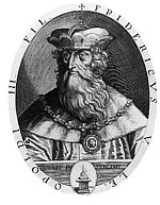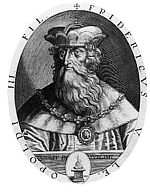
Frederick IV, Duke of Austria
Encyclopedia

Habsburg
The House of Habsburg , also found as Hapsburg, and also known as House of Austria is one of the most important royal houses of Europe and is best known for being an origin of all of the formally elected Holy Roman Emperors between 1438 and 1740, as well as rulers of the Austrian Empire and...
duke
Duke
A duke or duchess is a member of the nobility, historically of highest rank below the monarch, and historically controlling a duchy...
of Further Austria
Further Austria
Further Austria or Anterior Austria was the collective name for the old possessions of the House of Habsburg in the former Swabian stem duchy of south-western Germany, including territories in the Alsace region west of the Rhine and in Vorarlberg, after the focus of the Habsburgs had moved to the...
from 1402, and Count of Tyrol from 1406, until his death. He was the younger son of Leopold III, Duke of Inner Austria.
Frederick's rule over Tyrol
County of Tyrol
The County of Tyrol, Princely County from 1504, was a State of the Holy Roman Empire, from 1814 a province of the Austrian Empire and from 1867 a Cisleithanian crown land of Austria-Hungary...
and the scattered Habsburg territories in southwestern Germany
Germany
Germany , officially the Federal Republic of Germany , is a federal parliamentary republic in Europe. The country consists of 16 states while the capital and largest city is Berlin. Germany covers an area of 357,021 km2 and has a largely temperate seasonal climate...
and in the Alsace
Alsace
Alsace is the fifth-smallest of the 27 regions of France in land area , and the smallest in metropolitan France. It is also the seventh-most densely populated region in France and third most densely populated region in metropolitan France, with ca. 220 inhabitants per km²...
referred to collectively as Vorderösterreich (i.e., Further Austria
Further Austria
Further Austria or Anterior Austria was the collective name for the old possessions of the House of Habsburg in the former Swabian stem duchy of south-western Germany, including territories in the Alsace region west of the Rhine and in Vorarlberg, after the focus of the Habsburgs had moved to the...
) was formalized in 1402 through a partition of his father's inheritance. Later, in 1406, his elder brother Leopold IV
Leopold IV, Duke of Austria
Leopold IV of Austria, Duke of Further Austria was an Austrian Habsburg Duke of the Leopoldinian Line.He was the second son of Leopold III. His eldest brother Duke William of Inner Austria took him as his effective co-ruler, putting him in particular charge of Further Austria, which also meant...
ceded Tyrol to his sole rule when their eldest brother William died; and Frederick became sole ruler in Further Austria only upon Leopold's death in 1411. The early years of Frederick's reign were marked by external and internal conflicts. He had to overcome the opposition of the local nobles (who gave him the title of "Empty Pockets") in 1406/07, and had to deal with the independence movement in Appenzell
Appenzell
Appenzell is a region and historical canton in the northeast of Switzerland, entirely surrounded by the Canton of St. Gallen....
, which became a protectorate of the Old Swiss Confederacy
Old Swiss Confederacy
The Old Swiss Confederacy was the precursor of modern-day Switzerland....
in 1411.
When he sided with Antipope John XXIII
Antipope John XXIII
Baldassarre Cossa was Pope John XXIII during the Western Schism. The Catholic Church regards him as an antipope.-Biography:...
at the Council of Constance
Council of Constance
The Council of Constance is the 15th ecumenical council recognized by the Roman Catholic Church, held from 1414 to 1418. The council ended the Three-Popes Controversy, by deposing or accepting the resignation of the remaining Papal claimants and electing Pope Martin V.The Council also condemned and...
, Emperor
Holy Roman Emperor
The Holy Roman Emperor is a term used by historians to denote a medieval ruler who, as German King, had also received the title of "Emperor of the Romans" from the Pope...
Sigismund
Sigismund, Holy Roman Emperor
Sigismund of Luxemburg KG was King of Hungary, of Croatia from 1387 to 1437, of Bohemia from 1419, and Holy Roman Emperor for four years from 1433 until 1437, the last Emperor of the House of Luxemburg. He was also King of Italy from 1431, and of Germany from 1411...
placed him under the Imperial ban. Thanks to the support of the local populace he managed to keep Tyrol, but he lost the Aargau
Aargau
Aargau is one of the more northerly cantons of Switzerland. It comprises the lower course of the river Aare, which is why the canton is called Aar-gau .-History:...
, the old homeland of the Habsburgs, to the Swiss.
By 1425, his rule over Tyrol had stabilized, partially due to successful beginning of silver
Silver
Silver is a metallic chemical element with the chemical symbol Ag and atomic number 47. A soft, white, lustrous transition metal, it has the highest electrical conductivity of any element and the highest thermal conductivity of any metal...
mining that brought an increase in prosperity to the region.
Frederick also moved the court from Meran to Innsbruck
Innsbruck
- Main sights :- Buildings :*Golden Roof*Kaiserliche Hofburg *Hofkirche with the cenotaph of Maximilian I, Holy Roman Emperor*Altes Landhaus...
.
On 24 December 1407, Frederick married Elisabeth von Pfalz(1381–1408), daughter of Rupert, King of the Romans
Rupert of Germany
Rupert of Germany from the House of Wittelsbach was Elector Palatine from 1398 and German King from 1400 until his death...
in Innsbruck, but she died the following year.
On 11 June 1411 Frederick married Anna, daughter of Frederick, Duke of Brunswick-Lüneburg
Frederick, Duke of Brunswick-Lüneburg
Frederick , Duke of Brunswick-Lüneburg, was ruler of the Principality of Brunswick from 1373, and, according to some sources, briefly German king-elect in opposition to Wenceslaus in 1400....
; they had one son, Sigismund.

